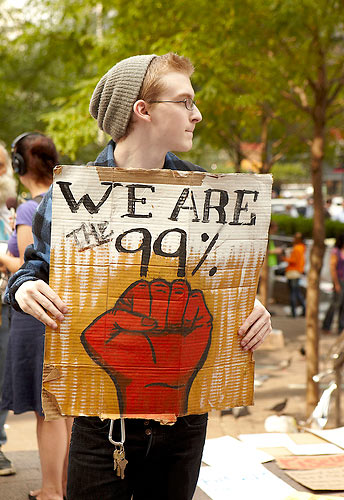Wall Street protests echo researcher’s findings on growing income gap
For Emmanuel Saez, a UC Berkeley professor of economics, reports about “Occupy Wall Street” protests — by demonstrators who claim to represent an overlooked 99 percent of the nation — must have a familiar ring.

Saez and French economist Thomas Piketty have been generating steady academic, governmental and public attention after reporting (in 2008) that from 2002 to 2007, the top 1 percent of American households accounted for about two-thirds of all income gains. In that time period, the top 1 percent saw their incomes increase more than 10 percent a year when adjusted for inflation, while the rest of the households – the 99 percent – had much more modest income increases of 1.3 percent a year.
In a 2010 paper titled “Striking it Richer: The Evolution of Top Incomes in the United States,” Saez provided 2007 to 2008 updates on the above-mentioned figures. The winner of a MacArthur Foundation “genius” grant in 2010, Saez found that the average real income for the top percentile fell 19.7 percent (resulting in a drop in the top percentile income share from 23.5 to 20.9 percent), average real income for the bottom 99 percent also fell sharply, by 6.9 percent. For that 99 percent, the drop was, by far, the greatest year-to-year decline since the Great Depression.
In a Q & A this week, Saez weighed in on the Occupy Wall Street demonstrations:
Q: What do you make of the Occupy Wall Street protesters’ claims that they “are the 99 percent.” Do you feel they are connecting – deliberately or not – with the bottom 99 percent that you have studied and written about?
A: As you mentioned above, one of the most striking developments of the U.S. economy is how the top 1 percent has pulled away from the bottom 99 percent. Because the top one percent has captured about half of income growth since the 1970s, income growth for the bottom 99 percent has been only about half of the macro-economic growth we always hear about in the press.
How is it possible that in a democracy the bottom 99 percent gets only half of economic growth? I read the claim of the Occupy Wall Street protesters that “We are the 99 percent” as a call for action in a democracy. In a well functioning democracy, the bottom 99 percent should be able to call for policies that will make the economy work better for the vast majority they are.
Q: Why do you think the Occupy Wall Street protests are happening now?

A:The 2008 economic crisis was largely the consequence of deregulated finance running amok. Even before the crisis, economic gains for the bottom 99 percent had not been that great. Although it was necessary to bail out Wall Street to prevent greater economic damage, the public got the impression that the government stepped in to help Wall Street without asking any significant sacrifice from Wall Street in return. As the Democratic Party has been in power since 2009, this triggered first a right-wing backlash against government. Although the Occupy Wall Street protest, along with many sister movements in Europe, also starts from a disillusion about government action, it comes with the constructive feeling that there must be a way the government can make things better.
Q: What are the key causes for the substantial income gaps in the United States today? What role does the size of the federal deficit play, if any?
A: New technologies and globalization cannot explain the dramatic increase in the U.S. income gaps because countries in continental Europe (such as France or Germany) and Japan are going through the same technological and globalization forces, yet are not experiencing such a dramatic increase in income gaps.
This implies that institutions, government policies and regulations, and social norms play a central role in shaping income gaps. To put things simply, the U.S. income gaps shrunk significantly after the Great Depression with the New Deal policies of stringent regulations and progressive taxation and widened significantly after the Reagan revolution that undid those regulations and progressive taxation.
Q: You have written that “we need to decide as a society whether this increase in income inequality is efficient and acceptable and, if not, what mix of institutional reforms should be developed to counter it.” Do you find the situation efficient and acceptable? Why or why not?
A: The extraordinary increase in income concentration in the United States from 2002 to 2007 was driven in large part by surging profits in the real estate and financial sectors made possible by deregulation. As we know, the financial-real estate bubble is what triggered the 2008 Great Recession that we are still struggling with.
Therefore, it seems clear today that this increase in inequality was inefficient and hence unacceptable.
In my view, the administration in Washington, D.C. should have been much more aggressive both in re-regulating finance and increasing progressive taxation. This would have been beneficial both to prevent such excesses from happening again and to fund the Wall Street bailouts and the stimulus packages necessary to fight the recession. Back in 2009, those policies could have been easily explained to the public and could have gathered both popular and congressional support.
Q: If the situation is unacceptable, what reforms in terms of economic and tax policy might offer the best counterbalances?
A: History and empirical evidence is again the best guide here. Philippon and Reshef have shown, a striking correlation between financial deregulation and relative wages in the financial industry in the Unites States over the 20th century.
Similarly, there is strong negative correlation between pre-tax income concentration and the progressivity of the tax system in the United States. Naturally, economists should and do argue about whether regulation and progressive taxation can stifle growth. Contrary to free-market dogma, the historical experience of most Western countries in the post-World War II decades shows that high regulation and highly progressive taxation can be associated with rapid and sustained economic growth.
Q: You direct the Center for Equitable Growth at UC Berkeley. Can you define equitable growth?
A: Equitable growth is economic growth that is widely and fairly distributed so that it benefits all: “a tide that lifts all boats.” Virtually all western countries experienced strong and yet equitable growth in the decades following World War II. This shows that growth and equity can go hand-in-hand.
Since the 1970s, growth has slowed down in most Western countries and has become much less equitable especially in English-speaking countries such as the United States. Hence, the interest among economists in understanding what policies could usher a new era of equitable growth.
Q: How is the center working to help develop public policy that can simultaneously improve the distribution of economic well-being and economic growth? Can you give some examples?
A: The center supports basic research by UC faculty and graduate students on equitable growth and funds visitors from other institutions. The goal is to create a vibrant and supportive environment for equitable growth research at Berkeley, especially for younger scholars. We have been supporting a variety of projects.
For example, we are supporting a collective effort aiming at constructing and maintaining a “World Top Incomes Database,” documenting trends in the evolution of income concentration over time and across countries. Another project, by my Economics Department colleagues Patrick Kline and Enrico Moretti, aims at analyzing whether public investment can shift regional growth, using the case study of the Tennessee Valley Authority which was started as part of the New Deal.
Our website lists all the projects we have been supporting.

Q:The logo of the Center for Equitable Growth is logo is based on the mathematics of the Golden Ratio and the Fibonacci spiral, composed of forms that grow yet remain proportionally equal. Can you explain how you developed the logo and what it means?
A: My wife Casey, a recent graduate from the California College of Arts, developed the logo for us. It symbolizes equitable growth, as the spiral grows “equitably” with all forms expanding yet keeping their initial proportions. It also symbolizes science, as it is based on the Fibonacci and Golden ratio mathematical sequence; hopefully this will inspire scientific discoveries in the field of equitable growth.
Q: How and why did you become so interested and engaged in the subject of income inequality?
A: Market economies have obviously been very successful at producing growth, but this growth often comes with large economic disparities. Those disparities matter, because people live in society and care about how they do relative to others. Historically, inequality has always been one of the very top criticisms of market economies. Hence, inequality is not only a technical subject for economic researchers, but an issue that can stir passion among the broader public, which makes it worthy of study.
Although I started studying mathematics at Ecole Normale Supérieure in Paris, I quickly realized that economics was the field where analytical tools could be used to cast light on deep issues in society — such as income inequality and what the government could or should do about it.
Q: Do you support the protests? Why or why not?
A: I definitely support the protests, as I think it is high time for the U.S. government to acknowledge and tackle head-on the issue of increasing income concentration. With political will and public support, there is no doubt in my mind that the government can have a major impact on inequality.
Protests are extremely important to make the public and the press aware of issues. In that sense, peaceful protests should play an important role in all societies, including our perfectible democracies. We know from history and from recent events that protests sometimes can change governments and have a decisive influence on policy making.
Q: Do you think the protests are having or may have significant impacts, or are they more just an expression of frustration by those outside the circles of Washington and financial industry decision makers?
A: The recent attention-grabbing success of the protests is already a sign of a significant impact. Whether they will have real policy consequences remains to be seen. The current disillusion among the public with the ability of government to accomplish anything positive is unfortunately not the best environment.
I wish those protests had started exactly three years ago, when hope in a better government was running high. Let us hope that a constructive alternative can arise from disillusion.
